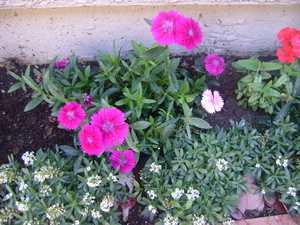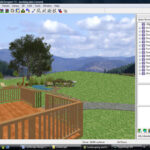When planning your garden, consider things such as maximum space allotment, drainage, ease of access, and potential hazards. For example, if the only space you have to plant is out front, plant away! However, for edibles and delicate varieties of foliage, consider the potential for neighborhood cats to wander into your garden beds. This may cause destruction of crops or flowers, and in the case of edibles, you will need to watch for signs of animal waste for sanitary reasons. Also, depending on your home owner’s association, you may not be allowed to have a vegetable garden out front, though you can grow flowers there. If that’s the case where you live, check out this article for great flower choices to border your home or walkway!
When selecting your space, drainage is important. Remember to consult your local utilities to ensure you will not hit any underground lines when digging out your space, whether you’re in your front, back or side yards. Once you know you’re in the clear, till the ground, level it back out and dig a hole at least eight inches deep and eight inches across. Fill the hole with water, and if it is dry in an hour or less, your drainage is sufficient. If it takes longer to drain, work some sand into the earth before planting.
If you have a small, but fairly low-traffic backyard (no young children or dogs), consider incorporating a garden theme throughout the space. Plant throughout the entire yard, leaving pathways and putting up some inexpensive fencing to mark barriers. Mix it up a little; a vegetable section, a flower bed, and maybe a strawberry patch, all working together, but in separate spaces. You can pile stones, build your own wooden fence, or install ready-made setups for enclosing garden areas.
Use a bench or two chairs and a bistro table to allow a spot for reflection in the garden, separate of any larger patio furniture you may have. Add details such as a whimsical garden gnome, or hang some wind chimes for even more interest. A hummingbird feeder and butterfly-friendly flower choices will ensure you have some delightful guests to your garden gatherings. To attract good fortune and create harmonious balance in your garden, consider a Feng Shui approach with tips in this guide.
If the backyard is pretty well spoken for, but you have a space at least four feet by six feet wide, you can still get down to work! Small as it may seem, this is plenty of space to grow a few tomatoes, several heads of lettuce, and maybe even a few watermelons! Perhaps you’d prefer a plot of sunflowers? No problem! Always consider sunlight requirements for the varieties you’d like to grow; some spots are better suited than others. Once it’s in the ground, you’re not going to want to mess with it, so determine your best “full sun” and “partial shade” spots before you dig!
Consider accenting a small garden bed with several planting containers. Many varieties of fruits, veggies, and flowers will grow nicely in pots with a good drainage hole, sunlight, a rich potting mix, and regular watering. Use fluffy, richly-colored soil to ensure plenty of nutrients get to the root system as it establishes itself. Pots with good drainage need to watered frequently, so monitor your soil conditions often.
If you can plant no true “garden” whatsoever, and are restricted to containers on a balcony or patio, get creative! Use regular pots to plant in, but seat each one in a slightly larger, decorative container to spruce the area up. Try and position your pots at different levels and heights to add interest, using plant stands, shelves and hanging baskets. Add a simple stone statue or small, free-standing fountain that you would find in a typical garden setting for an unexpected novelty.
If all else fails, consider a simple, counter-top herb garden in your kitchen! Check out this article on how to create a simple multi-herb pot for your counter-top or windowsill. Just a handful of small pots and a few packs of seeds can add delightful aromas and convenient culinary treats to your very own kitchen in a matter of weeks! Not only is creating an herb garden indoors fun, it’s practical and economical.
Indoors, there are fewer pests, and if you do attract a few little bugs, simply wash your herb plant with a mild dish soap and rinse thoroughly. Also, you can enjoy this activity all year long, as climate is of little concern indoors. Most herbs will do well at average room temperatures, between 60-80 degrees. You’ll save time and money by not running to the store to buy a big pack of herbs you won’t ever finish before the expiration just for one meal. For more money-saving, budget-friendly gardening ideas, check this out!
Use these tips to maximize your small space, and say good-bye to limitations!!




